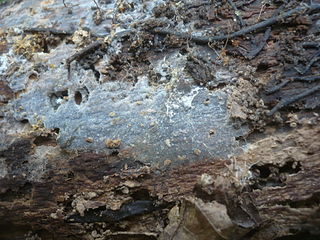Related Research Articles

Phanerochaete is a genus of crust fungi in the family Phanerochaetaceae.

The Phanerochaetaceae are a family of mostly crust fungi in the order Polyporales.
Candelabrochaete is a genus of crust fungi in the family Phanerochaetaceae.

Scopuloides is a genus of five species of crust fungi in the family Meruliaceae.

Phlebia is a genus of mostly crust fungi in the family Meruliaceae. The genus has a widespread distribution. Phlebia species cause white rot.
Roseograndinia is a fungal genus in the family Phanerochaetaceae. It is a monotypic genus, containing the single crust fungus species Roseograndinia rosea, recorded from tropical east Africa and from New Zealand.

Phlebiopsis is a genus of poroid crust fungi in the family Phanerochaetaceae. The genus contains 11 species, which collectively have a widespread distribution. The genome sequence of the type species, Phlebiopsis gigantea, was published in 2014.
Cericium is a fungal genus in the family Cystostereaceae. It is a monotypic genus with the single species Cericium luteoincrustatum, a crust fungus. This species was originally described in 1986 by Kurt Hjortstam and Leif Ryvarden, who called it Amethicium luteoincrustatum. They placed it in the genus Amethicium based on microscopic similarities with the African species Amethicium rimosum.

Cystostereum is a genus of crust fungi in the family Cystostereaceae. The generic name combines the Greek word κύστις ("bladder") with Stereum.
Parvodontia is a fungal genus in the family Cystostereaceae. This is a monotypic genus, containing the single species Parvodontia luteocystidia, a crust fungus that grows on bamboo in Brazil.
Cyanodontia is a fungal genus in the family Meruliaceae. It is a monotypic genus, circumscribed by mycologist Kurt Hjorstam in 1987 to contain the single species Cyanodontia spathulata. This is a toothed crust fungus that is found in East Africa. The type was collected by Leif Ryvarden in Tanga, Tanzania in 1973.
Gloeohypochnicium is a genus of wood-inhabiting crust fungi of uncertain familial placement in the order Russulales. Originally conceived by Erast Parmasto as a subgenus of Hypochnicium, Kurt Hjortstam considered it worthy of distinct generic status in 1987. The type species, G. analogum, was described as new to science in 1913 by French mycologists Hubert Bourdot and Amédée Galzin as a species of Gloeocystidium. G. versatum was added to the genus in 2010.

Hydnophlebia is a genus of five species of toothed crust fungi in the family Meruliaceae. All species are wood-decay fungi that cause a white rot.

Irpex is a genus of corticioid fungi in the order Polyporales. Species produce fruit bodies that grow as a crust on the surface of dead hardwoods. The crust features an irpicioid spore-bearing surface, meaning it has irregular and flattened teeth. Irpex is distinguished from the similar genera Junghuhnia and Steccherinum by the simple septa found in the generative hyphae.
Pirex is a fungal genus in the family Meruliaceae. It is a monotypic genus, containing the single crust fungus Pirex concentricus. It is found in the Pacific Northwest region of North America, where it causes a white rot in woody hardwood and conifer debris generated by timber harvesting.
Uncobasidium is a genus of two species of crust fungi in the Meruliaceae family. The genus was circumscribed by mycologists Kurt Hjorstam and Leif Ryvarden in 1978 with the European fungus U. luteolum as the type species. The South American species U. roseocremeum was added to the genus in 2012. The distinguishing feature of Uncobasidium is the basal hook in the basidium.

Dentocorticium is a genus of six species of poroid fungi in the family Polyporaceae. The genus was revised in 2018, with several new species added and some older species transferred to other genera, based on phylogenetic analyses.

Diplomitoporus is a genus of fungi in the family Polyporaceae. The Dictionary of the Fungi estimated the widespread genus to contain 11 species; since then, the genus has grown with the additional of several newly described species, and some transfers from other genera. Diplomitoporus has been described as a wastebasket taxon, containing "species that share common macroscopic and microscopic characteristics, but are not necessarily related."
Globuliciopsis is a genus of corticioid fungi in the order Polyporales. It currently contains two species found in Central and South America.

Hydnophlebia omnivora is a species of crust fungus in the family Meruliaceae. It causes white rot in various woody angiosperms, being found in arid regions of the Southern United States, northern Mexico, and Uruguay.
References
- ↑ Bresadola, G. (1925). "New species of fungi". Mycologia. 17 (2): 68–77. doi:10.2307/3753834.
- ↑ Hjortstam, Kurt; Bononi, Vera Lucia Ramos (1987). "A contribution to the knowledge of Corticiaceae s.l. (Aphyllophorales) in Brazil". Mycotaxon. 28 (1): 1–15.